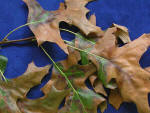|
 Keeping bugs out, and leaf scorch identified on oaks Keeping bugs out, and leaf scorch identified on oaks
By John
Fulton
 Send a link to a friend
Send a link to a friend
[August 27, 2007]
While mowing this weekend, I noticed thousands
of small crickets, ants and other assorted nuisance pests just
waiting to get into the house. A foundation treatment can at least
greatly reduce the number of these insects finding their way into
your home. A foundation treatment entails spraying the foundation of
the house and the adjacent foot or two of soil with permethrin or
bifenthrin insecticide. This treatment creates a chemical barrier
that the insects crawl through when trying to enter your home. If
they don't die on the outside, they are very short-lived on the
inside. You can expect the chemical treatment to last for three to
four weeks. Both of these chemicals are used on a wide range of
plants, so should present no problems to flowers, shrubs or turf.
|
 Once crickets are on the inside, there are few effective
options, and none that will do a good job over a period of time.
These options include spraying individual insects or small areas
with an aerosol product containing pyrethrins, spraying
baseboard areas with an aerosol containing permethrin, or using
a fly swatter. Once crickets are on the inside, there are few effective
options, and none that will do a good job over a period of time.
These options include spraying individual insects or small areas
with an aerosol product containing pyrethrins, spraying
baseboard areas with an aerosol containing permethrin, or using
a fly swatter.Foundation sprays are also effective against
ants, spiders, elm leaf beetles and other nuisance pests, so the
benefits are several for applying these treatments. Treatments
would need to be applied at least monthly, and people dedicated
to the program begin in May or June and continue through the
fall months. The addition of ant bait stations in the house
should aid your control efforts against ants. With the bait
stations, try not to spray anything indoors for about a week.
This allows the poison bait to get back to a nest.
Bacterial leaf scorch
Bacterial leaf scorch is an infectious plant disease caused
by a bacterium, Xylella fastidiosa. The pathogen is systemic,
living in the xylem. The most frequent U.S. hosts include elm,
oak, sycamore, mulberry, sweet gum, sugar maple and red maple.
In Illinois, we have identified the problem on oaks. At the U of
I Plant Clinic, the disease has been confirmed on pin oaks, red
oaks, shingle oaks, bur oaks and white oaks. Kentucky reports
BLS on pin, red, scarlet, bur, white, willow and shingle oaks;
silver, sugar and red maples; sweet gum; sycamore; plane tree;
hackberry; American elm; and red mulberry.
[to top of second column]

 |
 Look for scorch symptoms that occur in early summer to midsummer,
intensifying in late summer. The scorched leaf edges or tissue
between veins may be bordered by a yellow or reddish brown color,
but not in all cases. Symptoms occur first on one branch or section
of branches and slowly spread in the tree from year to year. It is
one of those situations that you hope will be better, but the
situation gets worse. On local pin oaks, it seems the bottom
branches die each year.
There is no cure. Some have tried injections with oxytetracycline,
but none have shown more than disease suppression with this
antibiotic. This suppression has been more common in the Southern
states rather than the Midwest. Because the pathogen is in the
xylem, cleaning pruning tools before moving to another tree is
important to reduce spread of the disease. Xylem-feeding leafhoppers
and spittlebugs are thought to spread the bacterium in landscape
trees. It can also be transmitted between trees through root grafts.
[Text from file received from
John
Fulton, University of Illinois Extension,
Logan County Unit]
 |